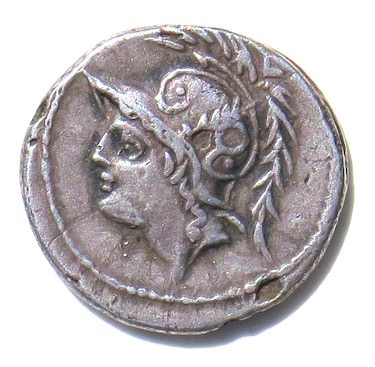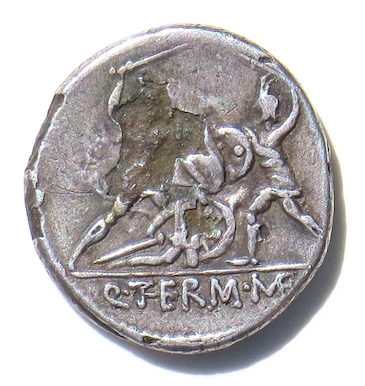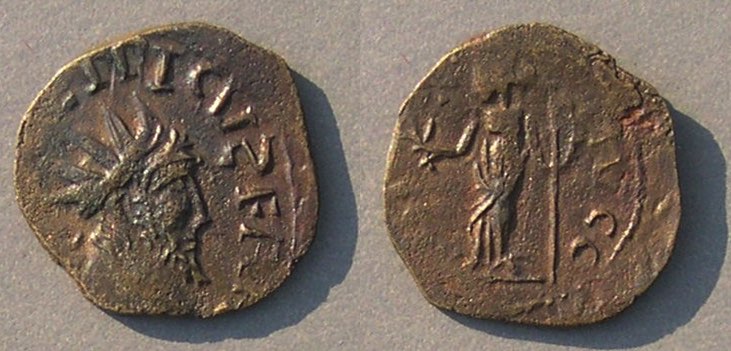

One way to make a profit by counterfeiting coins is to replace precious silver with inexpensive copper, while maintaining the appearance of good silver.


Two Roman Republican silver denarii from 103 BC. The one on the left is an ancient counterfeit with a copper-core silver-plated and then struck to make a convincing imitation of the genuine full-silver coin on the right. The silver plate has broken showing the copper core near the rim at 5:30 and on the helmet near the middle. The reverse, next, makes it clearer that it is an ancient fake. Prototype: Moneyer Q. Minucius Ter. M.F.
Obverse: Head of Mars in crested helmet left. Reverse: Two warriors fighting, the one on the left protecting a fallen comrade.
Silver denarius. 20-19 mm. 3.89 grams. Sear 197. Crawford 319/1.
Fourree: 19-18 mm. 3.53 grams.


The silver plating is broken on the coin on the left and the copper core shows through. In antiquity silver was worth, by weight, about 80-100 times as much as copper. The Republican denarius was nearly pure silver and valued as silver, so there was profit to be made by wrapping a copper core in a thin silver foil (much like aluminum foil) and striking it with false dies to make a "coin" called a "fourré" (= "stuffed" in French) with most of its weight actually copper. When the copper breaks, the fraud is exposed, but this imitation was struck in such good style and with thick enough silver that it may have been years before the foil detached. (For scholarly information about how these were produced see these references.)
 Comments, gentle criticisms, and questions are welcome.
Comments, gentle criticisms, and questions are welcome. Searching: Particular emperors and their relatives are on pages organized chronologically below. There is not a full-site search engine.
What's new? 2020, June 22: A page on barbarous radiates of the Gallo-Roman empire, c. 259-274.
2020, April 16: Septimius Severus fourré. (Fourth type down)
2018, Feb. 7: Magnificent Valentinian AE1.
New, 2107, Sept. 12: A Greek fourree drachm of Byzantion in Thrace (third coin down).
New, June 29, 2016: Many thumbnails replaced with larger images. Navigation improved.
Coins were counterfeited almost as soon as they were invented (c. 600 BC). This site discusses and illustrates imitations of Roman coins from c. 400 BC to c. AD 500 (with a few Greek coins at the end).
Imitations include:
1) counterfeit pieces intended to deceive in order to make a profit for the counterfeiter (usually silver-plated over a base metal core, as illustrated above), and
2) unofficial pieces intended to serve as small change (or, much less commonly, silver or gold money) in places where official coins were not in sufficient supply.
The term "imitation" is used for both, but is most appropriate for the second type where the imitations were more or less similar to official types, but not deceptive. The term "imitation" encompasses a wide variety of coin types from very small and crudely struck coppers minted in Britain to impressive full-weight gold pieces minted by German tribes.
 Counterfeits made for profit and intended to deceive usually imitate silver coins (denarii) with pieces of much less intrinsic value. Often called "fourrés" (occasionally spelled "fourrées" or "fourrees" when the accent is not used), they consist of silver-plated coins struck on flans with base metal cores and just enough silver on the outside to make them look like, and pass for, good silver. The profit was in the substitution of cheap copper for expensive silver in the core of the coin. You can see the copper of the core where the silver has broken off on this imitation of Trajan, AD 98-117.
Counterfeits made for profit and intended to deceive usually imitate silver coins (denarii) with pieces of much less intrinsic value. Often called "fourrés" (occasionally spelled "fourrées" or "fourrees" when the accent is not used), they consist of silver-plated coins struck on flans with base metal cores and just enough silver on the outside to make them look like, and pass for, good silver. The profit was in the substitution of cheap copper for expensive silver in the core of the coin. You can see the copper of the core where the silver has broken off on this imitation of Trajan, AD 98-117.
"Now what do you hold to be the most difficult calling," he [Trimalchio] went on, "after Literature? I think the doctor's and the money changer's; the doctor, because he's got to know what chaps have in their insides, and when the fever's coming, -- though truly I hate 'em like fury, for they're for ever ordering me duck-broth; the money changer, who detects the bronze underneath the surface plating of silver."The Satyricon, by Petronius, translation attributed to Oscar Wilde, p. 110
(Book Collector's Assn., N.Y., 1934.)
Go to more quotes from ancient sources.
"A sample of a forged denarius is carefully examined and the adulterated coin is bought for more than the genuine ones."Pliny, Historiae Naturalis XXXIII, translation by H. Rackham, Loeb edition, 1956


Counterfeits that served to augment the supply of small change were struck in copper in (usually) crude imitation of official types. A British imitation of a type of Claudius (AD 41-54) is illustrated here (reverse with Minerva striding right with spear and shield, S C on either side, 24 mm) with its 28 mm prototype to the right. Many counterfeits are not deceptive because their designs are so much cruder than official coins or their sizes are so much smaller than the official coins. Apparently the Roman government was often not interested in providing all provinces with coins to facilitate small monetary transactions. Then, in neglected provinces, the locals sometimes made their own unofficial coins. Much of the coinage of Roman Britain was locally and unofficially produced. Many "Claudian copies" are found at Roman forts and may have been produced by the military.
Coins were regularly counterfeited throughout the entire Roman period. Counterfeits were especially prominent in several periods and places. We sometimes use these terms:
1) "endemic" for regularly occurring counterfeits (e.g. silver-plated denarii under the Roman Republic)
2) "epidemic" for counterfeits that make up a substantial fraction of the coins in circulation (e.g. asses in Britain under Claudius in the mid-first century AD, or "barbarous radiates" in Britain and Gaul c. AD 270)
Warren Esty (c) 2001
Click on the links or images below to see more coins from each time period. The one link to Greek coins is at the end.
Some counterfeits were made by casting and some ancient molds are still extant. See here for some molds ("moulds" in Britain) and a description of one way it was done.
Chronological list. Click on the images or links to see imitations from that period.
^^^^^^^^^^^^^^^^^^^^^^^^^^^^^^^^^^^^^^^^^^^^^^^^^^^^^^^^^^^^^^^^^^^^^^^^^^^^^^^^^^^^^^^^

Roman Republican silver-plated coins
This piece: Pansa 9

Roman Republican AE
This piece: Spanish Republican semis
British Claudian AE and earlier AE imitations of Augustus, Agrippa, etc.
This piece: Claudius as
Other 1st and 2nd century AE imitations
This piece: Domitian
Limes-falsa of the second and third centuries
This piece: An imitation as of Hadrian.
Fourrées: The Twelve Caesars
This piece: Augustus
Fourrées: The 2nd Century
This piece: Commodus
Severan and later (AD 193 - 253) fourrés mostly from the Balkans
This piece: Philip II
Individual pages for: Septimius Severus, Julia Domna, Geta, Caracalla, Macrinus and Diadumenian, Elagabal, Severus Alexander, Maximinus, Gordian III, Philip's family, Trajan Decius and Trebonianus Gallus.
 "Barbarous radiates" of the Gallo-Roman empire (259-274)
"Barbarous radiates" of the Gallo-Roman empire (259-274)
Tetrarchy (AD 284-314)
This piece: Licinius
This page also has a few ancient molds for cast imitations.
Carausius, The British Empire
This piece: Allectus
Fourth Century
Constantinian (of five categories AD 307-360)

1) "Two Victories" type. This piece: Constantine
2) Types of AD 330-340. This piece: Constantine II
GLORIA EXERCITVS, VRBS ROMA, CONSTANTINOPOLIS, mules.
3) Other Constantinian types to AD 330.
This piece: Crispus
4) Types of AD 340-348.
This piece: Constans
5) FEL TEMP REPARATIO (AD 348 ff),
"galley," "soldier spearing fallen horseman," and other post-reform imitations.
This piece: An unusual full-sized Constantius II imitation.
Here is a page about ancient molds for making cast imitations of FEL TEMP REPARATIO coins.
Magnentius and Decentius (AD 350-353)
This piece: Magnentius FELICITAS REIPVBLICE
Julian's "bull" AE, (AD 361-363)
Plated siliquae and solidi
This piece: Julian II siliqua
Valentinian I and later AE (AD 364ff)
This piece: Gratian AE2
Greek
This piece: Alexander the Great tetradrachm
Links to off-site webpages can be found on my page about references.
Terms and links within this site.
[under construction -- not even close to ready. I am not actively working on it.]
fourré, fourree (how to identify a fourré)
"fourré" is a French word for "filled" or "stuffed" (in the case of coins, with base metal)
subaerat (the word for "fourreé" in German, meaning something like "below, AE")
limes
limesfalschung(en)
mold, mould (This site has a page with molds of coins of the tetrarchy and of FEL TEMP REPARATIO coins)
serratus, serratii
siliqua, clipped siliqua
Literature about ancient imitations, annotated.
Other websites on ancient imitations:
Imitations of Roman Republican denarii, by Phil Davis
A spectacular collection of ancient fourrees, by Aaron Emigh
Brockage fourrées, by Aaron Emigh
This entire site, copyright (c) 2002-2025 by Warren Esty
All rights reserved. If you want to use some of it, please ask. I will almost certainly give permission.
Comments and questions are welcome. I am seeking ancient quotations about ancient imitations. e-mail me at: 
This is the end of the main Table of Contents page on ancient Roman imitations.
Return to the Table of Contents of educational pages.